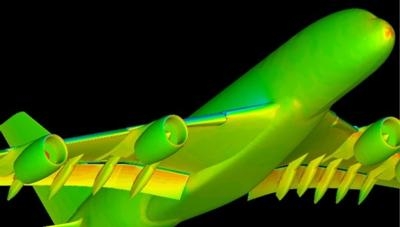DLR Supports European Research Into Eco-Efficient Flight
The German Aerospace Center (Deutsches Zentrum für Luft- und Raumfahrt or DLR) and 13 leading representatives of the European aviation industry and research sector have jointly agreed to intensify their cooperation in the field of eco-efficient aviation. Through the continuation of the EU 'Clean Sky' Technology Initiative, the partners aim to strengthen the transformation of aviation into an eco-efficient transport system. To this end, $4.6 million will be invested between 2014 and 2020 together with the EU. The Clean Sky 2 program will deliver more research and development for making aviation in Europe more environmentally friendly and more efficient. DLR is playing a leading role in this endeavor.

"The continuation of Clean Sky is an important step on the path towards a sustainable aviation sector with lower emission levels, less noise and greater efficiency," stated Rolf Henke, DLR Executive Board Member for Aeronautics Research.
The European aviation vision 'Flightpath 2050' and the new Strategic Research and Innovation Agenda (SRIA) of the European forum for aviation research ACARE (Advisory Council for Aviation Research and Innovation in Europe) set ambitious objectives for this research program. In 2050, aviation is expected to have achieved a 75 percent reduction in carbon dioxide emissions compared to the year 2000. There are also plans to reduce noise levels around airports by 65 percent.
At the present time, DLR is chairing the 'Technology Evaluator' at Clean Sky. Here, researchers are investigating the interaction between individual aviation technologies with the help of a simulated network. It is only through the interaction of individual components such as wings, engines, fuselage and tail unit that the full impact of an aircraft on its environment can be understood. For example, how much fuel can be saved if a more efficient engine is considered together with a wing design that optimizes airflow? Will the individual innovations have a positive effect on one another? As well as considering the aircraft as a whole – that is, as the sum of its parts – researchers are also looking into scenarios for airports of the future and into the development of global air traffic. In addition, DLR is involved in the three Clean Sky projects 'Smart Fixed Wing Aircraft', 'Green Rotorcraft' and 'Systems for Green Operations'.
In the 'Smart Fixed Wing Aircraft' project, the research partners are developing a new wing design, intended to have better aerodynamic flow properties. This concept will be tested on an Airbus A340. 'Green Rotorcraft' covers development work into quieter and more fuel-efficient helicopter components. One example of this is the new flow-optimized rotor blades. As part of the 'Systems for Green Operations' project, researchers are investigating quieter and more fuel-efficient flight paths and improved taxiways at airports. Scientists have also placed the purely electric operation of individual aircraft systems on their agenda.
Clean Sky 2 will be run under the auspices of the European Research Framework Program 'Horizon 2020'. Anchoring it in the central research and development program of the European Union means there is a solid financial basis for the continuation of the technology initiative. Leading industry partners of DLR in Clean Sky 2 include Airbus, Eurocopter, Safran, Thales Rolls-Royce, MTU Aero Engines and Liebherr.
(Image provided by DLR)
 Unfortunate... ANN/SportPlane Resource Guide Adds To Cautionary Advisories
Unfortunate... ANN/SportPlane Resource Guide Adds To Cautionary Advisories ANN FAQ: Turn On Post Notifications
ANN FAQ: Turn On Post Notifications ANN's Daily Aero-Term (04.29.24): Visual Approach Slope Indicator (VASI)
ANN's Daily Aero-Term (04.29.24): Visual Approach Slope Indicator (VASI) ANN's Daily Aero-Term (04.28.24): Airport Marking Aids
ANN's Daily Aero-Term (04.28.24): Airport Marking Aids ANN's Daily Aero-Linx (04.28.24)
ANN's Daily Aero-Linx (04.28.24)



